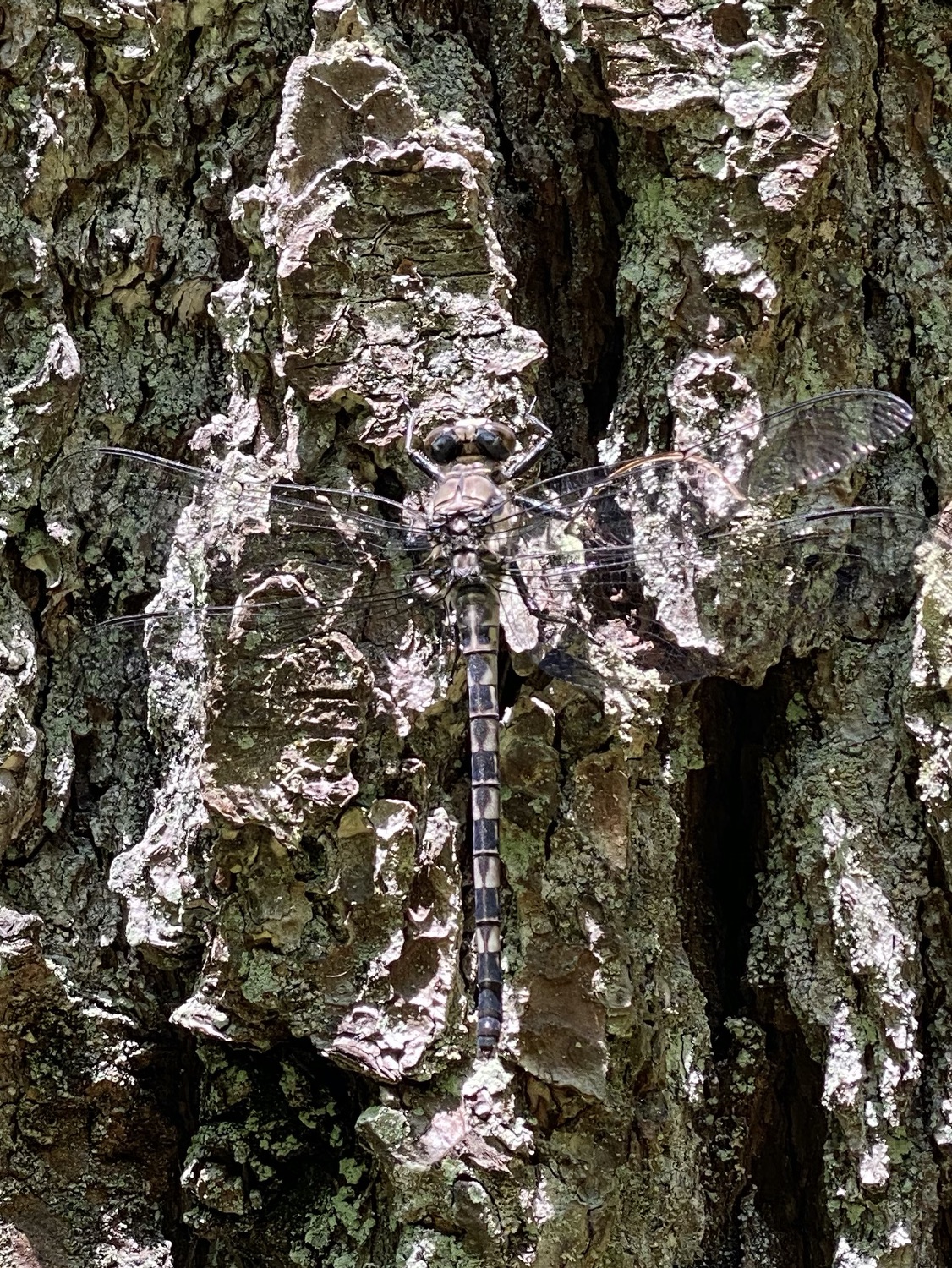DRAGONFLY BOOKENDS
6/7/20
My adventures today started and ended with unusual dragonflies: a Fawn Darner and a Gray Petaltail.
The Fawn Darner was the start of my day: it was perched on one of our deck posts. Darners are often hard to see because they’re always in motion, and many of them fly among the treetops. The best time to see them is like this morning, when they are vertically perched. Luckily with the cool morning temperature, it didn’t move as I took photos from all angles, and from quite close (less than a foot).

Fawn Darners are rather bland colored: the body is a muted brown with a few small yellow spots on the top of the thorax. The eyes are large and also brown, and they meet in a long seam in the middle, typical of darners (family Aeshnidae) in general. This one is slender, also typical of darners. One of the others identification clues is at the front tips of the wings: the long yellowish-tan patch, called the stigma. The stigma is often black on dragonflies, so it is always good to note an unusual color to one. The other characteristic of the Fawn Darner is also visible: the small dark spot at the base of each wing, four dark brown spots altogether, where the wing attaches to the body.

More clues come from the side view, especially the two prominent yellow spots on the side of the abdomen. There are also several smaller yellow spots along the thorax, with a larger one on segments S1-S2, just behind the abdomen. Without these, the brown color would make it blend in perfectly with the wood. Like the rest of the body, the legs are also brown. The small spines on the legs, just barely visible, help dragonflies catch their food while flying.

A front-on view also shows how non-descript the Fawn Darner is. The eyes seem oversized, and it is obvious that they meet along a seam on the top of the head, an important way to distinguish darners (and several other families) from three dragonfly families that have separated or barely-touching eyes, the Clubtails (Gomphidae), Petaltails (Petaluridae), and Spiketails (Cordulegastridae).
I spent the day hiking Curahee Mountain (more on the incredibly diverse wildflowers there later), then headed up to Clayton to one of my favorite dragonfly spots: Blackrock Lake, part of Blackrock Mountain State Park. Right near the parking lot, a small stream with brushy areas and mudflats enters the lake; it’s always a quiet area to watch dragonflies. Today, I also saw a Northern Watersnake (Nerodia sipedon) swimming, a small turtle basking on a log, and several frogs in the shallows.
Among the dragonflies, I saw many Common Whitetails (Plathemis lydia), several beautiful Calico Pennants (Celithemis elisa), a couple Violet Dancers (Argia fumipennis violacea), and one Lancet Clubtail (Gomphus (Gomphus) exilis). All are typical for this year, but they are so beautiful with the purple and blue of the Violet Dancer, the shocking red abdomen of the Calico Pennant, and the flashing broad white abdomens of the Common Whitetails. The Lancet Clubtail is the only subtle one, not only for its muted colors, but for its habit of perching horizontally on the mudflat, which had nearly the same color.
I was about to drive home, but I took one more short walk back to some picnic tables along the creek, and I startled several dragonflies as I approached the creek. One largish one flew off and perched vertically on the tree trunk, and I knew immediately it must be a Gray Petaltail (Tachopteryx thoreyi). Even though they aren’t rare, and they are found across much of the eastern United States, they can be hard to see. Their camouflage is excellent, they perch vertically on tree trunks instead of exposed on twigs, and they have an extraordinary tolerance for being approached.
Here it is:

What? You can’t see it? I’ll zoom in:

Subtle, right? A bird would have to be pretty eagle-eyed to spot one of these. This is only the second petaltail I have ever seen. The thorax is mostly a bland grayish-brown from above, although there are black stripes when seen from the side. The long and straight abdomen is a similar mud color, and is patterned with black. This pattern breaks up the dragonfly’s outline and make it hard to see. The eyes are dark and don’t touch. The wings are clear, without any distinguishing marks, except for black stigmas, which are hard to make out here except for the right rear wing.
Two hard-to-see dragonflies, bookending my day—pretty good!